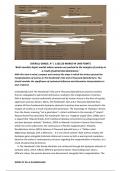OVERALL GRADE: A* | 110/120 MARKS 94 UMS POINTS
‘Both novelists depict worlds where women are pushed to the margins of society as
a result of patriarchal dominance.’
With this view in mind, compare and contrast the ways in which the writers present the
marginalisation of women in The Handmaid’s Tale and A Thousand Splendid Suns. You
should consider the significance of contextual influence and alternative interpretations in
your response.
Undoubtedly, both The Handmaid’s Tale and A Thousand Splendid Suns present societies
that are subjugated to patriarchal dominance, leading to the marginalisation of women.
With a dystopian society traditionally characterised by human misery in the form of squalor,
oppression and war (Green, 2021), The Handmaid's Tale and A Thousand Splendid Suns
employ all three fundamental dystopian elements to portray how women are pushed to the
margins of society as a result of patriarchal dominance. The etymology of “dystopia” derives
from the Greek, meaning “not a good place”, a direct antithesis to the concept of “utopia”.
Atwood herself has described The Handmaid's Tale as a “negative utopia”(Sirtl, 1998), yet it
is argued that “Atwood breaks from traditional dystopia conventions by juxtaposing present
and post-dystopia contexts” (Ketterer, 2020) as Atwood’s inclusion of events from history
within the novel underscores the continuance of female marginalisation. Similarly,
Nandakishore Varma (2014) believes A Thousand Splendid Suns is a “Taliban-ruled
Afghanistan dystopia with a difference…it is one which existed”. Both authors employ the
dystopian genre alongside historical references to serve as both a warning and a prophecy
based on the author’s contemporary concerns regarding the marginalisation of women, as a
result of patriarchal dominance.
In The Handmaid’s Tale female identities are reinforced through the dystopian element of
symbolic attire, which reflects different patriarchal values. By providing each value a
different colour, the women become one-dimensional, alongside their marginalisation. The
WORK OF ELLA SLINGERLAND
, Handmaid’s attire consists of “red shoes”, “red gloves”, white “wings” and a red
“ankle-length skirt”. Through their attire and the repetition of the colour “red”, the
Handmaids are marginalised as they become identical and lack identity to the extent that
Offred is “doubled” in comparison to the other Handmaids. When Offred asserts that red is
"the colour of blood which defines us," the metaphor evokes an unsettling atmosphere.
Throughout history, many cultures have viewed the passing of blood during menstruation
and childbirth as unclean, with some cultures insisting that women should be “churched” or
purified after childbirth (Kasten, 2015). In Gilead, Handmaids who menstruate are
considered to have failed in their duty to conceive, while those who give birth are celebrated
as triumphant. This emphasis on the colour red highlights how Gilead's oppressive regime
marginalises women by consistently reminding them of the consequences of failing to fulfil
their gender roles. Moreover, the plural pronoun “us” indicates a collective identity among
the Handmaids, highlighting how the enforced attire marginalises women collectively as
their attire plays a crucial role in defining their identity, which they lack individually.
Furthermore, Atwood's observation that "red is easier to see if you happen to be fleeing"
(Atwood, 2017) suggests that Handmaids are continuously monitored and that the enforced
attire enables the patriarchy to further marginalise women by creating an atmosphere of
entrapment and imprisonment. Contemporary readers are left uncertain regarding the
protagonist's true name, as Atwood withholds it (“My name isn't Offred, I have another
name”). However, the charactonym “Offred" indicates how patriarchal dominance
marginalises women through lack of self-identity as the Handmaids are named using
patronymics. Denoted by the prefix “Of” and the Commander’s masculine name that
follows, “Fred”, it signifies that the protagonist’s female identity and role within Gilead is
subsumed under a man’s ownership. A clear irony is evoked as although the name belongs
to and identifies Handmaids, the meaning of their name means that they belong to a man.
In this case, Offred’s name means “Of Fred”, which symbolises female subservience, further
connecting her to the gender roles of a Handmaid, reinforcing the marginalising idea that
Handmaids exist to benefit the patriarchy. Alternatively, Atwood could be prompting viewers
to contemplate the significance of traditional naming conventions and their ties to the
patriarchal structure of society. Indicating that the growing number of women who refuse to
take their spouse's last name after marriage have a desire to assert their sense of
self-identity and acknowledge the symbolic weight that names carry in shaping personal and
societal identity. Heidi Macpherson's (Macpherson, 2010) analysis suggests that the
protagonist's name is symbolic of how she is not fully aligned with her role - "off-red" (“as in
misread”) - and is often misunderstood and “afraid”. By assigning patronymic names and
enforcing attire on the Handmaids, women are marginalised as their existence is trivialised
through a constant reminder of their inferiority to the dominant gender of men; and that
Offred is objectified and commodified, thus stripped of her individuality, making her more
vulnerable to indoctrination.
Commander Fred's household serves as a symbolic representation of the power dynamics
in Gilead, correspondingly Rasheed's household in A Thousand Splendid Suns functions as a
WORK OF ELLA SLINGERLAND




